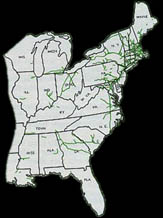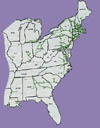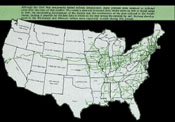 American
Rail: A Survey
American
Rail: A Survey American
Rail: A Survey
American
Rail: A Survey |
| Click on this map to see the status of rail in 1820 |
Rail transportation first amounted to horse or oxen-drawn carts run on wood rails. The advantage to any rail system is that it provides a clear path with less resistance than would occur on the ground. The refinement of steam engines offered a reliable and powerful motive force, but the weight of steam designs made ground travel difficult without some kind of specially prepared road or track. A steam powered cart would sink in soft earth. A road of rails and track could support great weights and reduce friction. The refinement and eventual reliability of steam locomotives provided Americans with a new system of land travel.
 |
| Click on this map to see the status of rail up to 1840. |
The first railroads were laid in the eastern United States. When they began service in 1830 there were less than 13 million people living in the country and its territorial holdings. Most people lived east of the Mississippi River. During this time, west of the Mississippi there were fewer people than there are in a medium sized city today. The railroads opened up the west with a relatively cheap, fast, and efficient means of transporting goods and people over great distances. Indeed, throughout the country, where railroads laid their tracks towns, industry, agriculture, and commerce grew.
 |
| Click on this map to see the status of rail in 1870 America. |
The growth of the country from the effects of the railroads was not without its costs. Small towns that failed to get tracks laid in their vicinity would often be subject to harsh economic decline. Other people had no say in the matter when the railroad came to town. Tracks were laid through once quiet neighborhoods, some people found their homes condemned to clear the way for the lines, and others found their towns divided by the tracks. Rail yards and terminals were large industrial areas where freight could be transferred, engines serviced, and goods shipped out. They destroyed the land, left hazardous wastes, bred disease, and made a general mess of the environment. Nevertheless, railroads took hold in America and participated in the transformation of the country, linking together diverse regions.